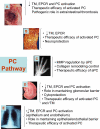The protein C pathway in tissue inflammation and injury: pathogenic role and therapeutic implications
- PMID: 20018912
- PMCID: PMC2920225
- DOI: 10.1182/blood-2009-09-201616
The protein C pathway in tissue inflammation and injury: pathogenic role and therapeutic implications
Abstract
Inflammation and coagulation are closely linked interdependent processes. Under physiologic conditions, the tissue microcirculation functions in anticoagulant and anti-inflammatory fashions. However, when inflammation occurs, coagulation is also set in motion and actively participates in enhancing inflammation. Recently, novel and unexpected roles of hemostasis in the humoral and cellular components of innate immunity have been described. In particular, the protein C system, besides its well-recognized role in anticoagulation, plays a crucial role in inflammation. Indeed, the protein C system is now emerging as a novel participant in the pathogenesis of acute and chronic inflammatory diseases, such as sepsis, asthma, inflammatory bowel disease, atherosclerosis, and lung and heart inflammation, and may emerge as unexpected therapeutic targets for intervention.
Figures



References
-
- Esmon NL, DeBault LE, Esmon CT. Proteolytic formation and properties of γ-carboxyglutamic acid-domainless protein C. J Biol Chem. 1983;258(9):5548–5553. - PubMed
Publication types
MeSH terms
Substances
Grants and funding
LinkOut - more resources
Full Text Sources
Other Literature Sources
Medical

